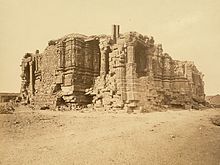Sack of Somnath
| Sack of Somnath | |||||||
|---|---|---|---|---|---|---|---|
| Part of Ghaznavid campaigns in India | |||||||
 Ruins of Somnath as viewed in 1869 | |||||||
| |||||||
| Belligerents | |||||||
| Ghaznavids | Chaulukya dynasty | ||||||
| Commanders and leaders | |||||||
| Mahmud of Ghazni | Bhima I | ||||||
| Strength | |||||||
| 60,000 | Unknown | ||||||
| Casualties and losses | |||||||
| Unknown |
50,000 killed Somnath sacked | ||||||
Location within Gujarat | |||||||
The Sack of Somnath in 1026 was a military campaign orchestrated by Mahmud of Ghazni, a ruler of the Ghaznavid Empire, directed against the Chaulukya dynasty of Gujarat. This is considered Mahmud's fifteenth invasion of India, which saw strategic captures and decisive battles and culminated in the destruction of the revered Somnath Temple. Facing staunch resistance, Mahmud's forces emerged victorious, resulting in significant casualties.
Entering Somnath in mid-January, Mahmud looted and burned the temple, earning him the title 'The Idol Breaker.' His swift departure encountered naval clashes with the Jats near the Indus River. Conducting a naval attack near the Indus River, Mahmud of Ghazni inflicted a severe defeat on the Jats, compelling them to retreat with substantial losses. This event remains a historical symbol of cultural clash and religious desecration during Mahmud's military campaigns in medieval India.
Background[edit]
The Somnath Temple, situated in Veraval, Gujarat, India, is a sacred Hindu temple. In 1026, Gujarat was under the rule of King Bhima I from the Chalukya dynasty.[1] Mahmud of Ghazni conducted multiple attacks on Indian kingdoms during that era.[2] Mahmud of Ghazni gained renown through campaigns in India, vassalizing the Gurjara Pratihara dynasty and overthrowing the Hindu Shahi dynasty. His successful campaigns against the Chandelas and other Hindu chiefs established him as a formidable figure among Indian kings.[3]
March towards Gujarat[edit]
On October 18, 1025, Mahmud of Ghazni embarked on a march from Ghazni, leading 30,000 cavalry and 30,000 camel riders equipped with essential resources like food and water. After a rest in Multan, they resumed their journey in November, proceeding through the desert.[4]
Mahmud initially seized the Ludrava pass, near Chiklodara Mata, close to Palanpur. By the end of December, he entered the Chalukya territories, prompting its ruler, Bhima I, to flee to Kachchh upon hearing of the Ghaznavid approach, fearing for his life.[3][4]
Mahmud of Ghazni stationed his army at Patan, bolstering resources for the campaign. A decisive battle unfolded with the Patan army at Mundher, where Mahmud emerged victorious. He then advanced towards Somnath, seizing the Somnath fort from Mandalika, the fort's overseer.[4]
At Somnath[edit]
Known as his fifteenth invasion of India, Mahmud's Somnath expedition targeted the temple located in the southernmost part of Kathiawar. By mid-January, Mahmud arrived at Somnath, encountering robust resistance from the Chalukya Rajputs. On the third day of the battle, the Ghaznavid forces found themselves surrounded, yet they ultimately triumphed, defeating the Chalukyas and causing 50,000 casualties among the defending forces.[5]
Mahmud of Ghazni, upon entering the temple, plundered the idols and shattered the Shiva Linga into pieces. He extensively looted and razed the temple to the ground. Within a month, Mahmud departed Somnath for Ghazni, facing numerous attacks from the Jats along the way.[4] Conducting a naval attack near the Indus River, Mahmud of Ghazni inflicted a severe defeat on the Jats, compelling them to retreat with substantial losses. This successful campaign earned Mahmud the title 'The Idol Breaker'.[5][6]
References[edit]
- ^ Majumdar, Asoke Kumar (1956). Chaulukyas of Gujarat: A Survey of the History and Culture of Gujarat from the Middle of the Tenth to the End of the Thirteenth Century. Bharatiya Vidya Bhavan. pp. 40–60.
- ^ Gupta, Nilima Sen (1984). Cultural History of Kapisa and Gandhara. Sundeep. ISBN 978-81-7574-027-3.
- ^ a b Sen, Sailendra Nath (1999). Ancient Indian History and Civilization. New Age International. ISBN 978-81-224-1198-0.
- ^ a b c d Munshi, Kanaiyalal Maneklal (1952). Somnath: The Shrine Eternal. Bharatiya Vidya Bhavan. pp. 35–40.
- ^ a b Mehta, Jaswant Lal (1979). Advanced Study in the History of Medieval India. Sterling Publishers Pvt. Ltd. ISBN 978-81-207-0617-0.
- ^ Jindal, Mangal Sen (1992). History of Origin of Some Clans in India, with Special Reference to Jats. Sarup & Sons. pp. 77–78. ISBN 978-81-85431-08-6.


